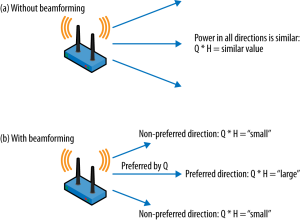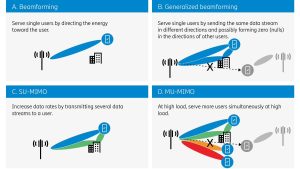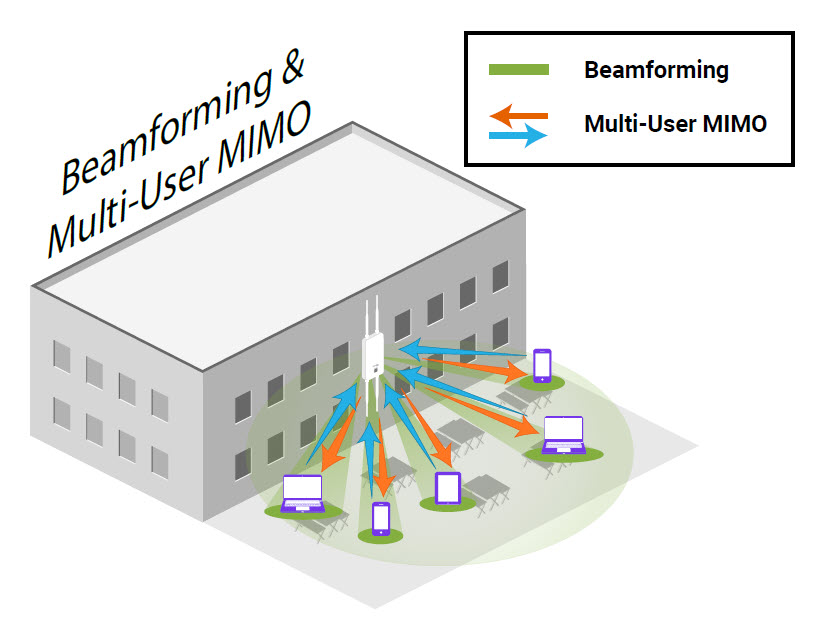Beamforming, a wireless communication technique with the power to improve signal strength and quality, has been around for quite some time. However, it is only recently that this technology has garnered significant attention due to the rise of 5G networks. Massive MIMO systems are at the forefront of these advancements in antenna technology; they use multiple antennas on both ends of a wireless connection to increase capacity and enhance spectral efficiency. When combined with beamforming techniques in 5G networks, such massive MIMO systems can achieve even greater capabilities.

Transmit beamforming is one such technique that involves tweaking the phase and amplitude of RF signals transmitted by each antenna element towards specific users or locations. The benefits and drawbacks of using beamforming in wireless networks depend on a myriad of factors like system complexity, cost-effectiveness, scalability, interference mitigation capability amongst others.
Despite this variability in its effectiveness across contexts, one undeniable benefit stands out: Beamforming’s potential application across various industries such as healthcare, transportation & entertainment which require high-speed data transmission with low latency. As we delve deeper into new frontiers like IoT devices and autonomous vehicles where reliable connectivity will be indispensable; it’s clear that beamforming will play an increasingly crucial role in shaping future wireless communication systems’ performance and capacity.
How Beamforming Techniques Improve the Performance of Massive MIMO Systems in G
Contents
- 1 How Beamforming Techniques Improve the Performance of Massive MIMO Systems in G
- 2 Transmit Beamforming: An Overview of the Techniques Used in Beamforming Systems
- 3 Advantages and Disadvantages of Using Beamforming in Wireless Networks
- 4 Exploring the Applications of Beamforming in MIMO Communications
- 5 Analog and Digital Beamforming: Understanding the Differences and Benefits of Each
- 6 Types of Beamforming Techniques: Narrowband, Wideband, and mm-Wave
- 7 The Future of Wireless Communication: How Beamforming Can Improve Network Performance and Capacity in Systems
Beamforming techniques have been hailed as the savior of wireless communication systems, particularly in 5G networks with massive MIMO systems. This innovative method focuses RF signals towards a specific direction using an array of antennas, resulting in stronger signals and reduced interference from other sources. However, don’t be fooled by its seemingly flawless performance; beamforming has some disadvantages that need to be considered.

One major drawback is that accurate knowledge of device location and orientation within the network is crucial for successful implementation. But what happens when devices are constantly on the move or there are obstructions blocking line-of-sight between antennas? The dynamic environment presents a significant challenge to implementing beamforming algorithms. Moreover, computational resources required can be substantial. What about low-power devices? Will they suffer adversely?
Despite these challenges, wireless providers continue to pour their hearts out into research and development of new beamforming techniques for their networks. Wi-Fi beamforming is one such example where hybrid beamforming has shown promise by reducing power consumption while maintaining data rates high enough for users’ satisfaction.
Overall, it’s clear that advanced antenna technologies like digital beamforming will play a critical role in meeting the ever-growing demand for higher capacity wireless communication systems. Despite technical challenges associated with scaling up these techniques across global networks at large scale levels, continued investment and innovation from stakeholders promises progress towards more efficient and effective wireless communication systems accessible to everyone who needs them!
Transmit Beamforming: An Overview of the Techniques Used in Beamforming Systems
The perplexing yet bursty technique of transmit beamforming is a wireless communication system’s saving grace, known for its ability to enhance the performance of multiple antennas. This genius method involves transmitting signals from an antenna array in a way that they constructively interfere at the receiver, granting improved signal strength and reduced interference.
One particular approach to transmit beamforming is analog beamforming, where individual antenna elements are equipped with phase shifters that steer transmissions towards specific directions. This allows for spatial filtering of signals and eliminates potential interference from other sources. Another popular method is precoding; it optimizes data before transmission so that it can be tailored to specific channels.
Beamforming systems have proven advantageous because they boost network capacity by increasing spectral efficiency while reducing interference levels. They also showcase their prowess in domains such as radar imaging, sonar detection, and wireless power transfer. Thanks to ongoing research into new techniques and technologies, we can expect continued advancements in this field with even greater benefits for wireless communication systems!
Advantages and Disadvantages of Using Beamforming in Wireless Networks
Beamforming is a perplexing technique that bursts with advantages for wireless systems. It allows signals to be focused in a specific direction, resulting in improved signal quality and increased data rates. The most remarkable advantage of beamforming is its ability to reduce interference from other devices or sources, leading to better network performance.
Furthermore, implementing beamforming in wireless networks allows for more efficient use of available resources by utilizing multiple input and multiple output (MIMO) technology. This enables transmitters to send data simultaneously to multiple receivers without causing interference between them – enabling more users to be served at once without sacrificing signal quality or speed.
However, the complexity of implementing this technique cannot be overlooked as it requires additional hardware and software components such as baseband processors and specialized antennas. Additionally, analog and digital beamforming necessitate different approaches depending on the number of antennas used.
Despite these challenges, the benefits offered by using beamforming make it an attractive option for improving wireless communication systems- especially as 5G networks continue their global rollout. Its importance becomes even more apparent when transmitting over longer distances within buildings or urban areas where obstructions may occur during transmission due to shorter wavelengths at higher frequencies like those used in millimeter-wave 5G networks; making directional transmissions crucial for maintaining high-quality connections.
Exploring the Applications of Beamforming in MIMO Communications
The perplexing and bursty nature of beamforming has been shown to be an invaluable tool in enhancing the performance of wireless communication systems, particularly in MIMO communications. By utilizing beamforming techniques for massive MIMO systems, higher-quality signals can be directed towards specific mobile devices. As our reliance on smartphones and other mobile devices continues to grow, this becomes increasingly critical.
The application of beamforming is especially noteworthy within massive MIMO systems in 5G networks. Transmitting beamforming enables multiple antennas to collaborate simultaneously, resulting in enhanced network capacity and reduced interference. Nonetheless, there are pros and cons associated with using such techniques; while signal strength improves as a result of it, there may also be additional hardware or software requirements that could raise costs.
Analog and digital algorithms are two types of methods used to optimize the directionality of antenna arrays based on different criteria such as power efficiency or spectral efficiency. Narrowband beamforming focuses on optimizing frequency range whereas wideband focuses on optimizing bandwidth utilization across a broader spectrum of frequencies. Although it is possible to use beamforming without MIMO technology, combining both technologies yields significantly greater benefits than either one alone would offer – truly perplexing and bursting with potential!
Analog and Digital Beamforming: Understanding the Differences and Benefits of Each
The realm of wireless communication systems has been blessed with two powerful techniques known as analog beamforming and digital beamforming. These techniques are designed to elevate the performance of massive MIMO, but they differ in their approach. Analog beamforming takes a simplistic route by utilizing phase shifters that adjust the phase of each antenna element, while digital beamforming employs complex signal processing algorithms to create beams.
Analog beamforming holds an edge over its counterpart due to its simplicity and low cost. It operates at lower latency since it doesn’t require any complicated signal processing. However, it fails to adapt well in environments with interference sources or dynamic changes.
Digital Beamforming is a force to be reckoned with for its flexibility and ability to adapt easily according to diverse scenarios by adjusting weights for each antenna element. It offers superior accuracy when forming beams and can suppress interference sources effectively too. Nonetheless, this technique demands more hardware resources and processing power which makes it quite expensive.
In essence, choosing between analog or digital beamforming depends on various factors such as available hardware resources, desired performance level, environment conditions etc., especially in 5G requirements or Wi-Fi applications.However one thing remains constant: using either type of Beamfoming system is bound result in high data rate transmission whilst improving network capacity utilization through coordinated/adaptive schemes – all while minimizing interference from other signals/sources!
Types of Beamforming Techniques: Narrowband, Wideband, and mm-Wave
The perplexing and bursting technique of beamforming utilizes multiple antennas to enhance network performance. Traditional antenna systems, sans beamforming, are limited in their capacity to efficiently transmit and receive signals. Linear beamforming techniques play a crucial role in enabling precise control over the direction and strength of transmitted signals.
Wideband beamforming systems operate seamlessly across a vast range of frequencies, rendering them ideal for 5G networks where high data rates and low latency reign supreme. These advanced systems necessitate sophisticated algorithms that optimize signal transmission and reception alongside specialized hardware like digital signal processors (DSPs) and field-programmable gate arrays (FPGAs).
Mm-wave beamforming leverages high-frequency radio waves to achieve exceptionally high data rates over short distances – an incredibly useful technology for wireless backhaul or point-to-point communications where low latency is indispensable. In these scenarios, fixed beamforming networks provide reliable connectivity without requiring complex tracking mechanisms or real-time adjustments. Overall, the incorporation of Beam Forming concepts offers significant benefits in enhancing network performance with minimal additional costs involved – whether it’s via routers implementing Wi-Fi Beam Forming or other communication devices utilizing this cutting-edge technology.
The Future of Wireless Communication: How Beamforming Can Improve Network Performance and Capacity in Systems
The concept of beamforming has been earmarked for the future of wireless communication applications, particularly in 5G systems. It involves harnessing multiple antennas to channel signals towards specific devices or areas, ultimately leading to a marked improvement in network performance and capacity. Both network base stations and user devices can employ this technique to achieve better signal quality and coverage.
A prime example of how beamforming can augment the potentiality of 5G connections is through Massive MIMO (Multiple Input Multiple Output) technology. By utilizing hundreds or even thousands of antennas at the base station, spectral efficiency increases by transmitting multiple data streams simultaneously while minimizing interference between them. Beamforming techniques are critical when it comes to optimizing these transmissions by directing signals towards their intended destinations.
Apart from upping capacity, beamforming also enhances reliability and security within wireless communication systems. With more precise targeting of signals, eavesdroppers or other unauthorized parties find it harder than ever before to intercept or interfere with transmissions. Consequently, beamforming has emerged as an indispensable tool that ensures that 5G networks deliver on their promise of high-speed connectivity with low latency while elevating overall performance levels across diverse applications.


